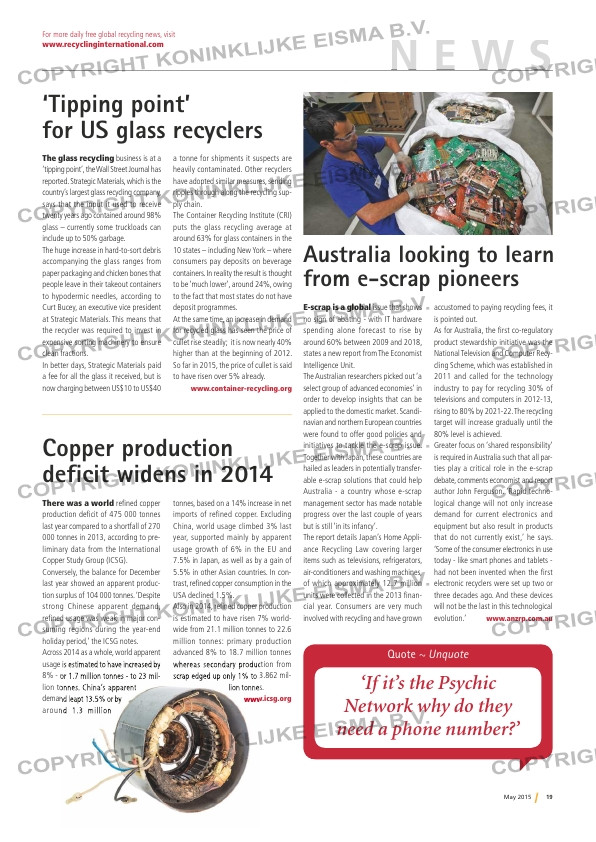Page 19 from: May 2015

N E W S
19May 2015
For more daily free global recycling news, visit
www.recyclinginternational.com
There was a world refi ned copper
production defi cit of 475 000 tonnes
last year compared to a shortfall of 270
000 tonnes in 2013, according to pre-
liminary data from the International
Copper Study Group (ICSG).
Conversely, the balance for December
last year showed an apparent produc-
tion surplus of 104 000 tonnes. ‘Despite
strong Chinese apparent demand,
refi ned usage was weak in major con-
suming regions during the year-end
holiday period,’ the ICSG notes.
Across 2014 as a whole, world apparent
usage is estimated to have increased by
8% – or 1.7 million tonnes – to 23 mil-
lion tonnes. China’s apparent
demand leapt 13.5% or by
around 1.3 million
tonnes, based on a 14% increase in net
imports of refined copper. Excluding
China, world usage climbed 3% last
year, supported mainly by apparent
usage growth of 6% in the EU and
7.5% in Japan, as well as by a gain of
5.5% in other Asian countries. In con-
trast, refi ned copper consumption in the
USA declined 1.5%.
Also in 2014, refi ned copper production
is estimated to have risen 7% world-
wide from 21.1 million tonnes to 22.6
million tonnes: primary production
advanced 8% to 18.7 million tonnes
whereas secondary production from
scrap edged up only 1% to 3.862 mil-
lion tonnes.
www.icsg.org
Copper production
deficit widens in 2014
E-scrap is a global issue that shows
no sign of abating – with IT hardware
spending alone forecast to rise by
around 60% between 2009 and 2018,
states a new report from The Economist
Intelligence Unit.
The Australian researchers picked out ‘a
select group of advanced economies’ in
order to develop insights that can be
applied to the domestic market. Scandi-
navian and northern European countries
were found to offer good policies and
initiatives to tackle the e-scrap issue.
Together with Japan, these countries are
hailed as leaders in potentially transfer-
able e-scrap solutions that could help
Australia – a country whose e-scrap
management sector has made notable
progress over the last couple of years
but is still ‘in its infancy’.
The report details Japan’s Home Appli-
ance Recycling Law covering larger
items such as televisions, refrigerators,
air-conditioners and washing machines,
of which approximately 12.7 million
units were collected in the 2013 fi nan-
cial year. Consumers are very much
involved with recycling and have grown
accustomed to paying recycling fees, it
is pointed out.
As for Australia, the fi rst co-regulatory
product stewardship initiative was the
National Television and Computer Recy-
cling Scheme, which was established in
2011 and called for the technology
industry to pay for recycling 30% of
televisions and computers in 2012-13,
rising to 80% by 2021-22. The recycling
target will increase gradually until the
80% level is achieved.
Greater focus on ‘shared responsibility’
is required in Australia such that all par-
ties play a critical role in the e-scrap
debate, comments economist and report
author John Ferguson. ‘Rapid techno-
logical change will not only increase
demand for current electronics and
equipment but also result in products
that do not currently exist,’ he says.
‘Some of the consumer electronics in use
today – like smart phones and tablets –
had not been invented when the fi rst
electronic recyclers were set up two or
three decades ago. And these devices
will not be the last in this technological
evolution.’ www.anzrp.com.au
Australia looking to learn
from e-scrap pioneers
Quote ~ Unquote
‘If it’s the Psychic
Network why do they
need a phone number?’
The glass recycling business is at a
‘tipping point’, the Wall Street Journal has
reported. Strategic Materials, which is the
country’s largest glass recycling company,
says that the input it used to receive
twenty years ago contained around 98%
glass – currently some truckloads can
include up to 50% garbage.
The huge increase in hard-to-sort debris
accompanying the glass ranges from
paper packaging and chicken bones that
people leave in their takeout containers
to hypodermic needles, according to
Curt Bucey, an executive vice president
at Strategic Materials. This means that
the recycler was required to invest in
expensive sorting machinery to ensure
clean fractions.
In better days, Strategic Materials paid
a fee for all the glass it received, but is
now charging between US$10 to US$40
a tonne for shipments it suspects are
heavily contaminated. Other recyclers
have adopted similar measures, sending
ripples through along the recycling sup-
ply chain.
The Container Recycling Institute (CRI)
puts the glass recycling average at
around 63% for glass containers in the
10 states – including New York – where
consumers pay deposits on beverage
containers. In reality the result is thought
to be ‘much lower’, around 24%, owing
to the fact that most states do not have
deposit programmes.
At the same time, an increase in demand
for recycled glass has seen the price of
cullet rise steadily; it is now nearly 40%
higher than at the beginning of 2012.
So far in 2015, the price of cullet is said
to have risen over 5% already.
www.container-recycling.org
‘Tipping point’
for US glass recyclers
RI 4-NEWS.indd 19 30-04-15 15:27



